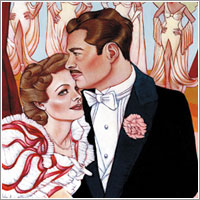 Full evening dress (also known as white tie) is the most formal dress code that exists for civilians today.1
Full evening dress (also known as white tie) is the most formal dress code that exists for civilians today.1
There exists a less formal counterpart known as black tie and a formal day time equivalent known as morning dress. See Formal wear for a complete listing and definition of formal dress codes.
A woman must wear a formal ball gown with her best accessories and jewellery when the dress is described as white tie. Where state decorations are specified, tiaras are usually worn by married women.
Elements
Formal evening dress is more strictly regulated than other forms of dress, and properly consists of:
- Black tailcoat with silk (ribbed or satin) facings, sharply cut-away at the front
- Black knee breeches
- White stiff-fronted shirt
- White stiff wing collar (attached to the shirt with collar studs)
- White bowtie
- White low-cut waistcoat
- Black silk stockings
- Black patent leather pumps with diamante buckles
Frequently trousers with two lines of braid replace the breeches, in which case the pumps are worn without buckles.
Shirts, waistcoats and bow ties are now usually made of cotton marcella, although plain linen shirts and white or off-white silk ties and waistcoats are sometimes worn. Shirt studs and cufflinks should be silver or white. A white handkerchief and flower may be worn. At occasions of state, and in the presence of royalty, state decorations are worn by those who have been awarded them: miniature medals plus up to four breast stars, a narrow neck riband and a broad riband (sash). If a Knight of the Order of the Garter choses to wear breeches, he wears his garter under his left knee. Ladies of the Garter wear theirs above their left elbow.
Outdoors a black silk plush top hat is appropriate, with an opera cloak or overcoat, even during the summer. White gloves, scarf and cane are optional extras.
Variations
Scottish Highland dress is often worn at white tie events, especially if worn by a Scotsman.
The traditional white tie version of Highland dress consists of:
- Black coatee - Prince Charlie, Montrose and Sheriffmuir jackets are suitable
- Black waistcoat
- Kilt
- White pique shirt and vest with white studs and cufflinks
- White bow tie
- Black Ghillie brogues
- Tartan or red and white, red and black or blue and white diced kilt hose
- Flashes
- Sporran - formal type with a silver-mounted cantle-top and fur pouch or a full fur and animal mask type
Military mess dress may also be seen at a White Tie event.
Occasions which warrant it
Like black tie, evening dress is generally only worn after 6 p.m. (see note 1 for an exception). Occasions that require white tie are increasingly rare, but in the United Kingdom these still include:
- State dinners (e.g. dinners with visiting heads of state)
- Commemoration balls and May balls at the Universities of Oxford and Cambridge
- Hunt balls
- Some balls during the London Season
The situation is similar in the United States, where "white tie" must be specified on the invitation. Occasion that may still require white tie in the US include:
- State dinners
- balls and cotillions
- Weddings
- Artistic premiers or the opening of an art season in large cities, such as the Opera or Ballet.
In Austria and elsewhere in Continental Europe there are many balls where white tie is worn. In Finland, Sweden as well as The Netherlands many academic traditions still require white tie. In Sweden many weddings are white tie as is the Nobel Prize ceremony and dinner occasions with the royal family.
Conductors and members of an orchestra or symphony playing classical music often are dressed in white tie.
Related forms of dress
White ties were historically worn by clerics and in the professions that formerly were filled by priests and minor clerics. In various forms they are still worn as part of:
- Clerical dress (by persons in Holy Orders)
- Clerical dress (by clerks etc. in Parliament)
- Court dress (in courts of law)
- Court dress (in the Royal court)
- Academic dress (in the older universities such as Oxford, Cambridge, St Andrews and Durham)
White ties are not worn with military mess dress, where black ties are worn even with the most formal variants. In the Royal Navy, mess dress (as opposed to mess undress) requires a white waistcoat but a black tie.
Note
1 In the United Kingdom civilian day court dress (in the Royal court) is similar to white tie, but nowadays white tie is worn in its place to the most formal state occasions, e.g. by foreign ambassadors at the State Opening of Parliament. This is the case even though such occasions occur during the day.